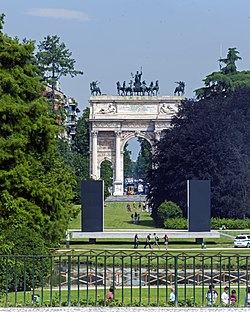
The Castello Sforzesco is a medieval fortification located in Milan, Northern Italy. It was built in the 15th century by Francesco Sforza, Duke of Milan, on the remnants of a 14th-century fortification. Later renovated and enlarged, in the 16th and 17th centuries it was one of the largest citadels in Europe. Extensively rebuilt by Luca Beltrami in 1891–1905, it now houses several of the city's museums and art collections.
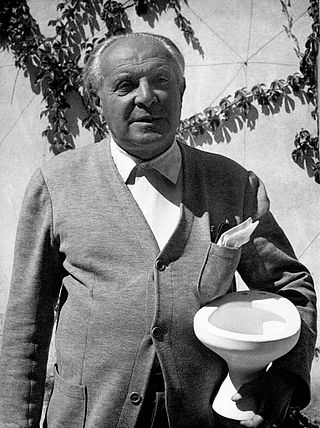
Giovanni "Gio" Ponti was an Italian architect, industrial designer, furniture designer, artist, teacher, writer and publisher.

Giuseppe Pagano was an Italian architect, notable for his involvement in the movement of rationalist architecture in Italy up to the end of the Second World War. He designed exhibitions, furniture and interiors and was an amateur photographer. He was also a long-time editor of the magazine Casabella.
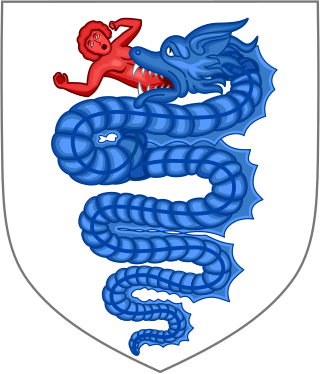
The biscione is in heraldry a charge consisting of a serpent in the act of eating or giving birth to a human. It is a historic symbol of the city of Milan, used by companies based in the city.

Portello is a district ("quartiere") of Milan, Italy, part of the Zone 8 administrative division of the city, located north-west of the centre. It is best known as a car-manufacturing area, as it used to house facilities of Alfa Romeo, Darracq, Citroën, and Fiat. The district also includes one of the major shopping malls in north-western Milan. It is crossed by the Circonvallazione ring road. Portello is adjacent to the new CityLife district.

The Triennale di Milano is a museum of art and design in the Parco Sempione in Milan, in Lombardy in northern Italy. It is housed in the Palazzo dell'Arte, which was designed by Giovanni Muzio and built between 1931 and 1933; construction was financed by Antonio Bernocchi and his brothers Andrea and Michele.

Cadorna FN is an underground interchange station in Milan, Italy, serving Lines 1 and 2 of the Milan Metro. The Line 1 station was opened on 1 November 1964 as part of the inaugural section of the Metro, between Sesto Marelli and Lotto. The Line 2 station was opened on 3 March 1978 as the southern terminus of the extension from Garibaldi FS. It served as the southern terminus of Line 2 until the extension of the line to Porta Genova on 30 October 1983.

Porta Sempione is a city gate of Milan, Italy. The name is used both to refer to the gate proper and to the surrounding district (quartiere), a part of the Zone 1 division, including the major avenue of Corso Sempione. The gate is marked by a landmark triumphal arch called Arco della Pace, dating back to the 19th century, although its origins can be traced back to a gate of the Roman walls of Milan.

Torre Branca is an iron panoramic tower located in Parco Sempione, the main city park of Milan, Italy. It is 108.6 m high, which makes it the sixth highest structure in Milan after Unicredit Tower, Allianz Tower Palazzo Lombardia, Pirellone or Pirelli Tower and the Breda Tower. The top of the tower is a panoramic point whose view, on a clear day, may encompass the Milan cityline as well as the Alps, the Apennines, and part of the Po Valley.

The Zone 1 of Milan, since 2016 officially Municipality 1 of Milan, is one of the 9 administrative divisions of Milan, Italy.
The following is a timeline of the history of the city of Milan, Italy.

Antonio Bernocchi was an Italian industrialist, who built up a successful textile factory at Legnano, in Lombardy.

Antonio Perazzi is an Italian garden designer, landscape architect, botanist, writer and journalist. He is an expert in naturalistic and ecological garden.
The Milan Triennial is an art and design exhibition that takes place every three years at the Triennale di Milano Museum in Milan, Italy.

The Mirabello Castle lies in what was once the Parco Visconteo, near Mirabello di Pavia. Between the 14th and 16th centuries, it was the seat of the Captain of the Park, the authority administering the Parco Visconteo on behalf of the Visconti and Sforza families. Only a wing of the original castle has survived.

Visconti Park was the private park of the Visconti and Sforza families, lords, and dukes of Milan. Located in Lombardy, northern Italy, it extended between the Pavia Castle and the Pavia Charterhouse. It covered an area of about 2,200 hectares (22 km2) and was encircled by walls about 25 kilometres (16 mi) in length. It was founded in 1360 by Galeazzo II Visconti and enlarged by his son Gian Galeazzo. Its decay began in 1525 with the damages inflicted during the Battle of Pavia. Today, the park's area mainly serves agriculture purposes, while some portions are nature reserves.

The Visconti Castle, or Castello Visconteo, is a castle in the town of Cusago near Milan, Lombardy, Northern Italy. It was built in the 14th century by Bernabò Visconti and used as a hunting lodge by him and other Visconti family members. The castle underwent significant changes in the Renaissance period; today, it is in neglected conditions.
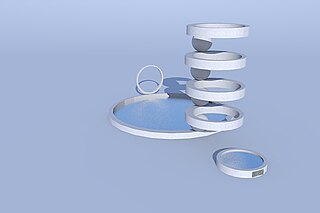
The Milan Triennial VI was the Triennial in Milan sanctioned by the Bureau of International Expositions (BIE). Its theme was Continuity – Modernity. It was held at the Palazzo dell'Arte with some exhibits on the Parco Sempione and ran from 31 May 1936 - 1 November 1936.
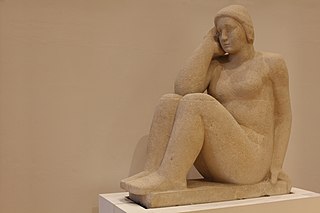
The Milan Triennial V was the first to be held at the Palazzo dell'Arte, the first recognised by the Bureau of International Expositions and also the first to be a triennial event.

Palazzina Appiani is a historical building located in Milan, northern Italy. It was built as the entrance hall of the arena at the beginning of the 19th century by the French, who occupied Milan in 1796. Its original function was to be the official gallery and guest residence to host Napoleon's family during his public appearances. It is located in Parco Sempione, the biggest park in the city, which also comprises the Sforza Castle and the Arch of Peace. Adjacent to the Arena Civica, the Palazzina is now entrusted to FAI – Fondo Ambiente Italiano.
